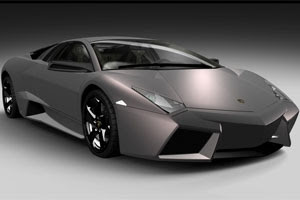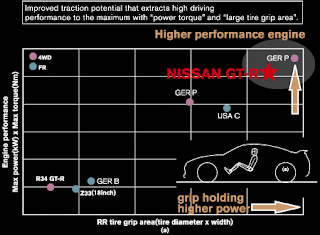
The Ferrari FXX is a car developed as part of an unusual development program by automobile manufacturer Ferrari in Maranello, Italy. It began production in 2005.
The car uses some technology developed from the Enzo Ferrari and combines it with some all-new developments from Ferrari and some of the suppliers. However, the car is only a part of the overall program: people pay £1.3 million ($2.5 million USD) but are only allowed to drive the car on special track days approved by Ferrari and after they drive the car they have to brief Ferrari on the car's performance. Michael Schumacher was given the last one (number 30) when he retired from Formula One racing at the end of 2006. Ferrari's sister company, Maserati, has developed a similar car, the MC12 Corsa.
The Car
This car was loosely built with the same idea in mind as when Ferrari made its F50 GT.
Essentially an evolution of the Enzo, the FXX shares some components with its parent car, but significant portions are exclusive to the FXX.
The FXX's engine is based on the Enzo's but has been expanded to 6,262 cc (from 5,988 cc), and output has been boosted from 660 PS (651 hp/485.4 kW), as seen in the Enzo, to 812 PS (800.9 hp/597.2 kW) @ 8,500 rpm.
The gearbox incorporates the latest developments from Ferrari's F1 program and has a shift time under 100 ms. The brake pads are upgraded compared to those on the Enzo. It does, however, retain the ceramic discs found on the Enzo.
The tires on the FXX are 19 in (483 mm) slicks custom-developed for the car, though road-legal.
As with the Enzo, the seat and pedal configuration are custom fit to the user's exact measurements.
The FXX features a comprehensive data-monitoring and telemetry that not only allows the driver to improve performance, but also provides Ferrari technicians with valuable data to improve the FXX and future road-going Ferraris.
Ferrari has built 30 (original number 29) of these cars, and they have all been sold to preselected past Ferrari customers, except for one that Ferrari S.p.A. kept, including Ferrari's F1 World Champion driver, Michael Schumacher, the 30th. Schumacher's FXX differs from others in that it is the only black FXX without a stripe and comes with red trim on the wheels, matte exhaust tips (regular FXX's have chrome tips),it has also holds the famous MS signature on the side in red, number 30 on the doors and his personal insignia on the seats. These few customers will not only own a Ferrari FXX, but also participate in further testing and brand development. As the vehicle is not street legal, owners have the option of storing the car at Ferrari's facilities. As part of the FXX program, the car is maintained by the Ferrari factory. The purpose of this particular program is to allow Ferrari's top customers exclusive access to its most up-to-date technology and to use their input to help develop future models. The FXX was reported to cost 1.5 million euro (excluding taxes)[1], for the car and the services that Ferrari provides with it
Specifications
- Engine: Longitudinal, Mid-mounted, 75, naturally-aspirated aluminum V12
- Valvetrain: DOHC, 4 valves per cylinder with continuously variable timing
- Fuel system: Bosch Motronic ME7 Sequential Electronic Injection
- Specific Output: 127.75 PS (126 hp/94 kW) per litre
- Drive system: RWD w/TCS
- Construction: Carbon fiber body over carbon fiber tub with rear alloy subframe
- Front brakes: Brembo CCM (carbon-ceramic) discs w/6-pot calipers, power assist ABS
- Rear brakes: Brembo CCM (carbon-ceramic) discs w/4-pot calipers, power assist ABS
- Front wheels: 483 mm (19 in) x 229 mm (9 in)
- Rear wheels: 483 mm (19 in) x 330 mm (13 in)
- Steering: Rack and pinion with power assist
- Suspension: Double wishbones with push-rod actuated coil-shock units, adaptive dampers, electronic shock absorbers, anti-roll bar
- Wheelbase: 2650 mm (104 in)
- Front track: 1660 mm (65 in)
- Rear track: 1650 mm (65 in)
- Rear view is provided by a mounted video camera viewed on a small inboard screen.

FXX Evolution
The Ferrari FXX program will continue until 2008/2009. The car will have so called Evolution kit, that will improve the car even more powerful. The 6262 cc V12 engine will be pushing out 860 PS (848 hp/633 kW) at 9500 rpm, also gearbox is tweaked and shift time has been reduced by 20 milliseconds and it will take now only 60 milliseconds. The car has also aerodynamic changes and traction control system is also made better.

 The exterior styling clearly takes on Ford Europe's latest "kinetic" design language, following along the lines (so to speak) of the Ford Iosis concepts, among others. And those lines mark a radical departure from the comparatively conservative styling production Volvos employ, and what was previously expected to continue with the XC60 as well. To compete with the increasingly crowded premium compact SUV segment, that could be just what Volvo needs to cut ahead of the pack. The interior, meanwhile, is very i, Robot ...tres slick, but don't expect much to carry over to production aside from the modern trademark Volvo floating console-dash panel.
The exterior styling clearly takes on Ford Europe's latest "kinetic" design language, following along the lines (so to speak) of the Ford Iosis concepts, among others. And those lines mark a radical departure from the comparatively conservative styling production Volvos employ, and what was previously expected to continue with the XC60 as well. To compete with the increasingly crowded premium compact SUV segment, that could be just what Volvo needs to cut ahead of the pack. The interior, meanwhile, is very i, Robot ...tres slick, but don't expect much to carry over to production aside from the modern trademark Volvo floating console-dash panel. 








 At the 77th Geneva Motor Show a few months back, Opel unveiledtheir GTC Concept, which stands for Grand Tourismo Coupe, as well as a refreshed brand logo. As Bryan Nesbitt, Executive Director, GM Europe Design comments, “Our team strategized to envision the new essence of Opel – more confident, relevant, and distinctive – in a high performance, yet versatile, four-seat coupe. This style is what to expect of future Opel products.”
At the 77th Geneva Motor Show a few months back, Opel unveiledtheir GTC Concept, which stands for Grand Tourismo Coupe, as well as a refreshed brand logo. As Bryan Nesbitt, Executive Director, GM Europe Design comments, “Our team strategized to envision the new essence of Opel – more confident, relevant, and distinctive – in a high performance, yet versatile, four-seat coupe. This style is what to expect of future Opel products.”
 Like a pair of black Prada loafers with the signature red stripe on the heal, the GTC's interior also uses red stripes to accent the leather seats as well as the top point of the leather-wrapped steering wheel. Very Euro-chic indeed. The dashboard and center stack is laid out in matte black finish contrasted with glossy piano black trim pieces. The multitude of center stack buttons is backlit in red to mimic the controls of high end European audio equipment, while the driver enjoys a set of analog gauges encased in metallicrings and lit up in a warm orange glow. The instrument dials are reminiscent of the cars from the 1950s, which creates a unique balance between contemporary and classic design.
Like a pair of black Prada loafers with the signature red stripe on the heal, the GTC's interior also uses red stripes to accent the leather seats as well as the top point of the leather-wrapped steering wheel. Very Euro-chic indeed. The dashboard and center stack is laid out in matte black finish contrasted with glossy piano black trim pieces. The multitude of center stack buttons is backlit in red to mimic the controls of high end European audio equipment, while the driver enjoys a set of analog gauges encased in metallicrings and lit up in a warm orange glow. The instrument dials are reminiscent of the cars from the 1950s, which creates a unique balance between contemporary and classic design. 




















